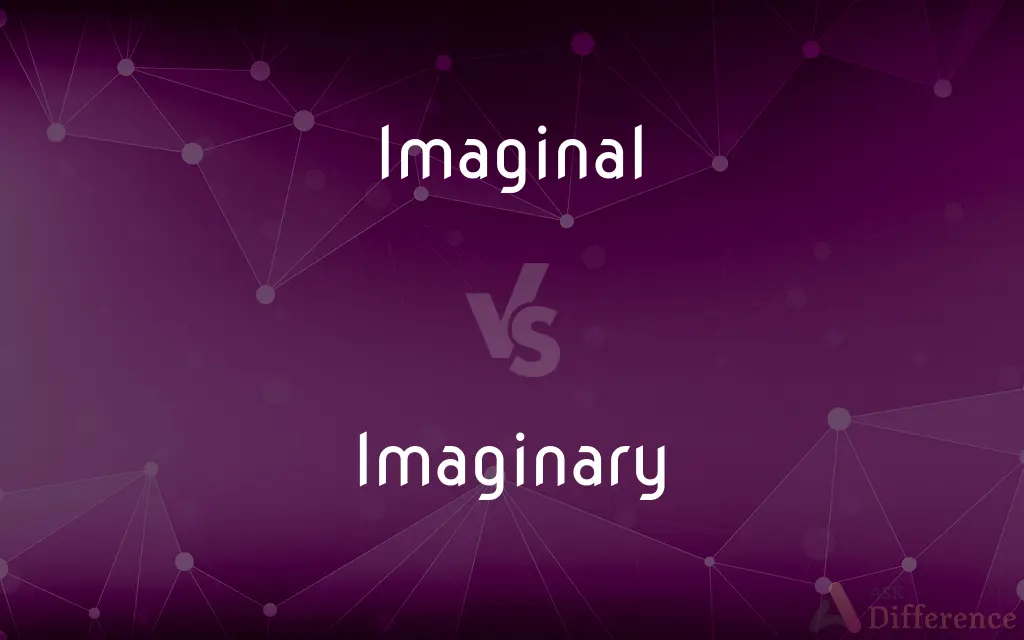Imaginal vs. Imaginary — What's the Difference?
By Tayyaba Rehman & Urooj Arif — Updated on May 16, 2024
Imaginal refers to the mental imagery used in therapeutic contexts, whereas imaginary pertains to something existing only in the mind and not in reality.

Difference Between Imaginal and Imaginary
Table of Contents
ADVERTISEMENT
Key Differences
Imaginal is a term often used in psychological and therapeutic contexts to describe mental imagery or visualization used as a tool for treatment. Imaginary, on the other hand, refers to things that exist only in the mind and are not real. This term is more broadly used in everyday language to describe something made up or fictional, such as an imaginary friend or an imaginary world in a story.
In therapeutic settings, imaginal techniques are structured and intentional, aiming to achieve specific psychological outcomes. These techniques harness the power of the mind's ability to visualize and simulate experiences to facilitate healing and personal growth. Imaginary elements, however, are generally unstructured and arise naturally as part of human creativity and imagination, often for entertainment or conceptual thinking.
Imaginal work requires active and conscious effort to create specific mental images that can evoke emotional responses and facilitate cognitive change. This practice is typically guided by a therapist and is grounded in psychological theory and practice. In contrast, imaginary concepts are spontaneous and not necessarily tied to therapeutic goals or processes.
Both terms involve mental processes but differ significantly in their application and purpose. Imaginal pertains to deliberate mental exercises used in therapy, while imaginary describes fictional creations of the mind without a basis in reality.
Comparison Chart
Definition
Mental imagery used in therapy
Existing only in the mind, not real
ADVERTISEMENT
Usage Context
Psychological and therapeutic settings
Everyday language, fiction, and creativity
Purpose
Therapeutic goals, emotional processing
Creative expression, conceptual thinking
Nature
Structured and intentional
Unstructured and spontaneous
Example
Imaginal exposure therapy
Imaginary friend
Compare with Definitions
Imaginal
Related to mental imagery in therapy.
In imaginal exposure, patients visualize feared situations to reduce anxiety.
Imaginary
Existing only in the mind, not real.
The child had an imaginary friend named Sam.
Imaginal
Involving the creation of mental images for psychological purposes.
The therapist used imaginal techniques to help the client process trauma.
Imaginary
Created by the imagination.
The story takes place in an imaginary world.
Imaginal
Utilized in cognitive-behavioral interventions.
Imaginal desensitization is a method used for phobia treatment.
Imaginary
Fictional and not physically present.
Her fear of imaginary monsters kept her awake at night.
Imaginal
Mental visualization aimed at achieving therapeutic outcomes.
Imaginal rehearsal helps individuals prepare for stressful events.
Imaginary
Not based on reality.
He told an imaginary tale about dragons and wizards.
Imaginal
(Psychology) An often idealized image of a person, usually a parent, formed in childhood and persisting unconsciously into adulthood.
Imaginary
Existing only in the imagination
Chris had imaginary conversations with her
Imaginal
A representation of the form of a person or object, such as a painting or photograph.
Imaginary
(of a number or quantity) expressed in terms of the square root of a negative number (usually the square root of −1, represented by i or j).
Imaginal
A sculptured likeness.
Imaginary
Having existence only in the imagination; unreal.
Imaginal
(Physics) An optically formed duplicate, counterpart, or other representative reproduction of an object, especially an optical reproduction formed by a lens or mirror.
Imaginary
Of or being the coefficient of the imaginary unit in a complex number.
Imaginal
One that closely or exactly resembles another
He is the image of his uncle.
Imaginary
Of, involving, or being an imaginary number.
Imaginal
Likeness; semblance
Genesis says that man was made in the image of God.
Imaginary
Involving only a complex number of which the real part is zero.
Imaginal
The opinion or concept of something that is held by the public
The public's image of business leaders as greedy.
Imaginary
An imaginary number.
Imaginal
The concept or character projected to the public, as by a person or institution, especially as interpreted by the mass media
An actor who tried to convey an image of refined beauty.
Imaginary
Existing only in the imagination.
Unicorns are imaginary.
Imaginal
A typical example or embodiment
That child is the image of good health.
Imaginary
Having no real part; that part of a complex number which is a multiple of (called imaginary unit).
Imaginal
A mental picture of something not real or present
Our image of the cottage did not conform with reality.
Imaginary
Imagination; fancy.
Imaginal
A vivid description or representation in words, especially a metaphor or simile
The poem uses the image of a barren tree to convey feelings of desolation.
Imaginary
(mathematics) An imaginary quantity.
Imaginal
(Mathematics) A set of values of a function corresponding to a particular subset of a domain.
Imaginary
(sociology) The set of values, institutions, laws, and symbols common to a particular social group and the corresponding society through which people imagine their social whole.
Imaginal
(Computers) An exact replica of the contents of a storage device, such as a hard disk, stored on a second storage device, such as a network server.
Imaginary
Existing only in imagination or fancy; not real; fancied; visionary; ideal.
Wilt thou add to all the griefs I sufferImaginary ills and fancied tortures?
Imaginal
(Obsolete) An apparition.
Imaginary
An imaginary expression or quantity.
Imaginal
To make or produce a likeness of
Imaged the poet in bronze.
Imaginary
Not based on fact; dubious;
The falsehood about some fanciful secret treaties
A small child's imaginary friends
Her imagined fame
To create a notional world for oneself
Imaginal
To mirror or reflect
A statue imaged in the water.
Imaginary
Conceptual and inventive.
The artist's painting depicted an imaginary landscape.
Imaginal
To make a visual representation of (an object) using remote scanning or technology such as magnetic resonance imaging
Imaged the diseased kidneys.
Imaged the surface of Mars.
Imaginal
To symbolize or typify
A kneeling woman imaging the nation's grief.
Imaginal
To picture mentally; imagine or visualize
Imaged each dive before doing it.
Imaginal
To describe, especially so vividly as to evoke a mental picture
The passage images what it's like to grow up poor.
Imaginal
To print (a file) using a laser printer, imagesetter, direct-to-plate press, or similar device.
Imaginal
To transmit (an exact replica of the contents of a storage device) to another storage device
Imaged the hard drive to the server.
Imaginal
Of or relating to the imagination, or to a mental image.
Imaginal
Of or relating to the insect imago.
Imaginal
Characterized by imagination; imaginative; also, given to the use or rhetorical figures or imagins.
Imaginal
Of or pertaining to an imago.
Imaginal
Pertaining to the use of guided imagery in healing.
Imaginal exercises are effective in treating PTSD.
Common Curiosities
How is imaginal used in therapy?
Imaginal techniques are used in therapy to help individuals confront and process fears, traumas, and other emotional challenges through guided visualization.
What does imaginary mean?
Imaginary pertains to things that exist only in the mind and are not real, often used in the context of fiction or creativity.
What are common examples of imaginary things?
Common examples include imaginary friends, fictional characters, fantasy worlds, and mythical creatures.
Are imaginal techniques used only in therapy?
Primarily, yes. Imaginal techniques are structured methods used in psychological therapies, though similar visualization techniques can be used for relaxation and self-help.
How does imaginal rehearsal work?
Imaginal rehearsal involves visualizing oneself successfully performing a task or handling a situation, which can enhance confidence and preparedness in real-life scenarios.
Is imaginal exposure effective?
Yes, imaginal exposure is an effective therapeutic technique for treating anxiety, PTSD, and other psychological conditions by helping individuals confront and process distressing thoughts and memories.
What psychological theories support imaginal techniques?
Theories such as cognitive-behavioral therapy (CBT) and exposure therapy support the use of imaginal techniques for addressing anxiety, trauma, and other psychological conditions.
What is the difference between visualizing and imagining?
Visualizing often implies a more structured and purposeful mental imagery process, while imagining can be more spontaneous and creative.
What is the meaning of imaginal?
Imaginal refers to the use of mental imagery or visualization techniques, often in a therapeutic context to address psychological issues.
Can something be both imaginal and imaginary?
While both involve mental imagery, imaginal is structured and used for therapeutic purposes, whereas imaginary is more general and refers to fictional or unreal creations.
How do therapists guide imaginal exercises?
Therapists guide imaginal exercises by helping clients create detailed mental images related to their issues, often using scripts or prompts to facilitate the process.
Why are imaginary friends common in childhood?
Imaginary friends are common in childhood as they allow children to explore creativity, practice social skills, and navigate emotions in a safe, imaginative way.
Do imaginary concepts have real-world applications?
While imaginary concepts themselves are not real, they can inspire real-world creativity, problem-solving, and innovation in various fields like literature, art, and science.
Can adults have imaginary friends?
While less common than in children, some adults may have imaginary companions, often as a coping mechanism or creative outlet.
Are imaginary fears common in adults?
Yes, adults can have imaginary fears, which are unfounded fears about unlikely or fictional scenarios, often stemming from anxiety or irrational thoughts.
Share Your Discovery

Previous Comparison
Provider vs. Vendor
Next Comparison
Miscibility vs. SolubilityAuthor Spotlight
Written by
Tayyaba RehmanTayyaba Rehman is a distinguished writer, currently serving as a primary contributor to askdifference.com. As a researcher in semantics and etymology, Tayyaba's passion for the complexity of languages and their distinctions has found a perfect home on the platform. Tayyaba delves into the intricacies of language, distinguishing between commonly confused words and phrases, thereby providing clarity for readers worldwide.
Co-written by
Urooj ArifUrooj is a skilled content writer at Ask Difference, known for her exceptional ability to simplify complex topics into engaging and informative content. With a passion for research and a flair for clear, concise writing, she consistently delivers articles that resonate with our diverse audience.
















































